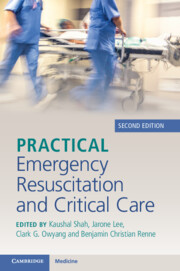Book contents
- Practical Emergency Resuscitation and Critical Care
- Practical Emergency Resuscitation and Critical Care
- Copyright page
- Contents
- Contributors
- Preface
- Section 1 General Critical Care
- Section 2 Infectious Disease Emergencies
- Section 3 Neurological Emergencies
- Section 4 Cardiovascular Emergencies
- 16 Post-Cardiac Arrest Care
- 17 Acute Coronary Syndrome
- 18 Acute Decompensated Heart Failure
- 19 Aortic Dissection
- 20 Hypertensive Emergencies
- 21 Valvular Diseases
- Section 5 Respiratory Emergencies
- Section 6 Gastrointestinal Emergencies
- Section 7 Renal Emergencies
- Section 8 Hematology–Oncology Emergencies
- Section 9 Endocrine Emergencies
- Section 10 Environmental Emergencies
- Section 11 Trauma
- Section 12 End of Life
- Index
- References
20 - Hypertensive Emergencies
from Section 4 - Cardiovascular Emergencies
Published online by Cambridge University Press: 02 November 2023
- Practical Emergency Resuscitation and Critical Care
- Practical Emergency Resuscitation and Critical Care
- Copyright page
- Contents
- Contributors
- Preface
- Section 1 General Critical Care
- Section 2 Infectious Disease Emergencies
- Section 3 Neurological Emergencies
- Section 4 Cardiovascular Emergencies
- 16 Post-Cardiac Arrest Care
- 17 Acute Coronary Syndrome
- 18 Acute Decompensated Heart Failure
- 19 Aortic Dissection
- 20 Hypertensive Emergencies
- 21 Valvular Diseases
- Section 5 Respiratory Emergencies
- Section 6 Gastrointestinal Emergencies
- Section 7 Renal Emergencies
- Section 8 Hematology–Oncology Emergencies
- Section 9 Endocrine Emergencies
- Section 10 Environmental Emergencies
- Section 11 Trauma
- Section 12 End of Life
- Index
- References
Summary
Hypertension is defined as a systolic blood pressure (SBP) higher than 130 mmHg, or a diastolic blood pressure (DBP) higher than 80 mmHg. Hypertension may be essential (primary), meaning that it is not linked to an obvious underlying cause, or it may be secondary to a known etiology or other systemic disorder.
Of people with known hypertension, 1–2% will present with an acutely elevated blood pressure referred to as a “hypertensive crisis.” It is often due to factors that exacerbate a preexisting hypertension, such as medication noncompliance or substance abuse.
- Type
- Chapter
- Information
- Practical Emergency Resuscitation and Critical Care , pp. 177 - 186Publisher: Cambridge University PressPrint publication year: 2023



